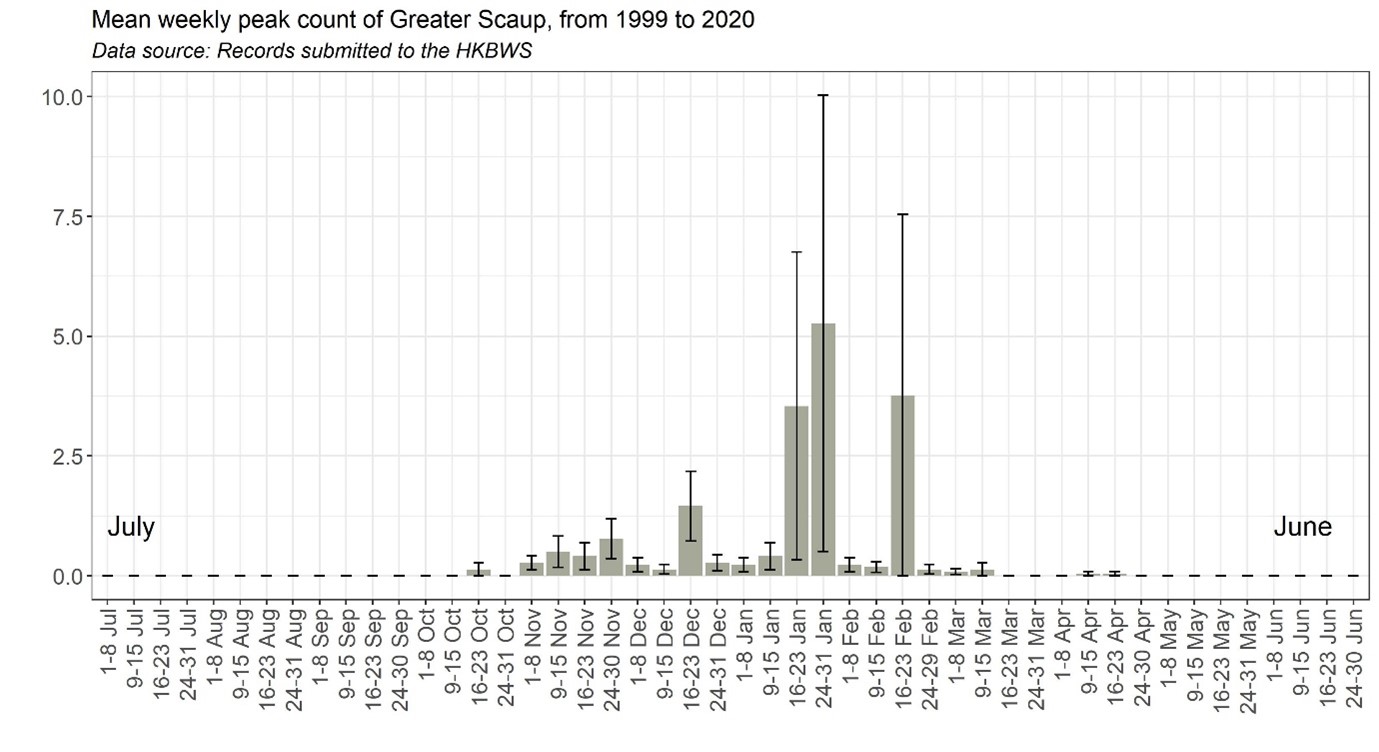Greater Scaup Aythya marila 斑背潛鴨
Category I. Rare winter visitor to Deep Bay area.
IDENTIFICATION

Jan. 2010, Michelle and Peter Wong.
40-51 cm. Compared to Tufted Duck, Greater Scaup has larger more rounded head, more gradually sloping rear of the body, smaller more triangular black tip to bill and lacks a crest on the head. Adult male has finely vermiculated grey and white mantle, pure white flanks, green-glossed blackish head and blue-glossed blackish chest.

Jan. 2010, Michelle and Peter Wong.
Female has pale grey-tinged flanks and dark mantle, which sometimes has pale vermiculation visible at close range, and a large area of white at base of the bill (usually obviously above the top of the bill). Adult male eclipse similar to breeding plumage but much duller and less well-marked.
VOCALISATIONS
Largely silent away from the breeding grounds. The female utters a growling call when flushed that is slightly longer than that of Tufted Duck .
DISTRIBUTION & HABITAT PREFERENCE
Greater Scaup occurs in the Outer Deep Bay area, with the highest numbers occurring on inshore waters along the coast from Tsim Bei Tsui to Lau Fau Shan. Counts of seven or fewer have been made at Mai Po NR and on commercial fish ponds from Lut Chau to Hoo Hok Wai.
There are five records away from the Deep Bay area: at Starling Inlet a pair on 11 February 1980 and a female on 3 November 2009, two female/immatures at Nam Chung during 9-19 December 1988, an immature male at Shuen Wan on 5 January 1992 and one along the Shing Mun River at Sha Tin on 31 December 2020.
OCCURRENCE
Greater Scaup is a winter visitor to Deep Bay from the first week of November to the third week of February (Figure 1), a period of occurrence that has remained consistent since 1958. Extreme dates are 23 October 2010 and 16 April 2006, though the next latest in spring is 10 March.
The highest counts occurred from 21 January to 17 February 2006 when up to 83 birds (reported on the last date) were present in the Tsim Bei Tsui to Lau Fau Shan area. The next highest count is of 25 on 24 December 1959. As Figure 2 indicates, the numbers that occur each winter vary considerably.
Kershaw (1904) reported Greater Scaup as ‘common during the winter’ along the coast of Guangdong, and Vaughan and Jones (1913) reported that very large flocks were seen in Tolo Harbour in December and that males were frequently seen in small flocks. La Touche (1931-34) stated it was ‘a common duck on the southeast coast of China in the winter’. Macfarlane and Macdonald (1966), however, reported only three records. Although these assessments are not quantified, it would appear there has been a significant decline in the numbers of this species occurring in HK. As it lies at the southerly limit of the published regular range, it is thus possible that milder winter weather arising from climate change is a factor as it allows birds to remain further north.
BEHAVIOUR, FORAGING & DIET
No observations.
RANGE & SYSTEMATICS
Breeds across the Holarctic largely between 50oN and 75oN, and winters to the south, along the coasts of the western and eastern Pacific, northwest Europe, the Black and Caspian Seas, and in Asia from the Kuriles south through east Asia to southeast China (Kessel et al. 2020). In China it is a passage migrant in the northeast and winters along the lower and middle reaches of the Yangtze, scattered areas of south China and Taiwan (Liu and Chen 2020).
Of the two subspecies, the most likely to occur in HK is A.m. nearctica, which breeds in northeast Asia and North America. The nominate breeds in northern Eurasia.
CONSERVATION STATUS
IUCN: Least Concern. Population trend decreasing.
Figure 1.

Figure 2.

Kershaw. J. C. (1904). List of birds of the Quangtung Coast, China. Ibis 1904: 235-248.
Kessel, B., D. A. Rocque, and J. S. Barclay (2020). Greater Scaup (Aythya marila), version 1.0. In Birds of the World (S. M. Billerman, Editor). Cornell Lab of Ornithology, Ithaca, NY, USA. https://doi.org/10.2173/bow.gresca.01
La Touche, J. D. D. (1931-34). Handbook of the birds of Eastern China Vol. 2. Taylor and Francis, London.
Macfarlane, A. M. and A. D. Macdonald, revised by Caunter, J. R. L. and A. M. Macfarlane (1966). An Annotated Check-list of the Birds of Hong Kong. Hong Kong Bird Watching Society, Hong Kong.
Vaughan, R. E. and K. H. Jones (1913). The birds of Hong Kong, Macao and the West River or Si Kiang in South-East China, with special reference to their nidification and seasonal movements. Ibis 1913: 17-76, 163-201, 351-384.
Liu, Y. and Y. H. Chen (eds) (2020). The CNG Field Guide to the Birds of China (in Chinese). Hunan Science and Technology Publication House, Changsha.

